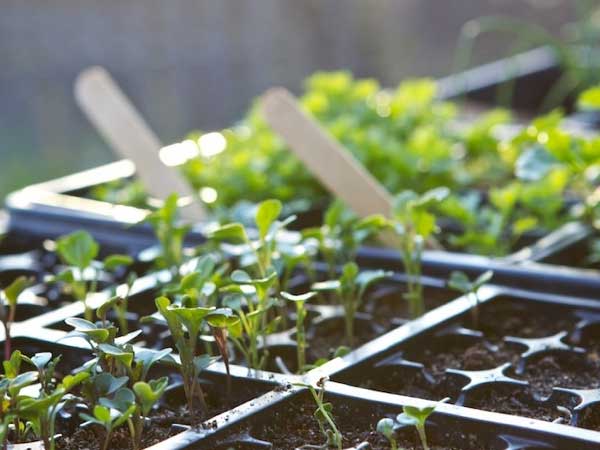Plenty of time for a “seedy” experience

Soil is the brown stuff in the bottom. Photo: Susy Morris, Creative Commons, some rights reserved
Based on recent excavations in northern NY State, archeologists have reached a stunning conclusion. Apparently, beneath layers of snow and ice there may still be “soil” in our region. It’s been so long since the presence of soil was confirmed, many people had begun to doubt its continued existence.
With the issue of object impermanence resolved, gardeners can get ready to start seeds indoors. If you’re new at this, the materials list can be perplexing. You’ll need to scrounge up the right amounts of light, warmth, drainage, timing and sanitation. Seeds would be helpful, too.
Timing is important. If you sow too early, plants will become leggy and weak-stemmed before it’s warm enough to plant them out. On the other hand, a crop like eggplant needs enough time to mature—if you’re too late starting you might end up with few or no fruit. But if it’s on your list to err in this process, better to do so on the side of late planting as opposed to early.
Many vegetables such as tomatoes do best when started indoors about 6 weeks before the last frost, which in northern NY varies from the end of April to early June depending on your elevation and latitude. You can find average last frost dates online, or call your Cooperative Extension office if you don’t have Internet access. Squash, melons, pumpkins and cukes do well with only a 3-week head start, but sow your peppers and eggplant about 7 weeks before last frost. Onions and leeks need 10 weeks.
Any container that’s at least three inches deep with large holes in the bottom for drainage will do. If they were used for plants before, immerse them in a 10% bleach solution and allow to drip dry.
Make sure your potting soil contains no soil. To clarify, a good planting medium is a sterile mixture of peat moss and absorbent minerals like perlite or vermiculite. It’s disease-free and provides good soil aeration as well as water-holding ability. Pre-moisten the mix before filling your containers.
Read each seed packet carefully—it will give tips on timing and care as well as planting depth. Most seeds are planted about twice as deep as they are wide. Very tiny seeds like cardinal flower should be pressed in to the surface and not covered up.
After planting your seeds, water the containers from the bottom—they’ll have to be in trays of some sort. An aluminum baking sheet works great if you can spare one. From experience I can say that labeling your containers is time well spent.
Temperature is critical for germination. 70-75 degrees is ideal, so don’t start them on your windowsill. Keep containers moist but not soggy, and don’t fertilize yet. After plants come up, dial down the heat. Cool-season plants like broccoli, cabbage and lettuce will thrive at 45-50 degrees, but warm-season plants like tomatoes and peppers should be kept at 65-70 degrees in the day and 55-60 at night.
Basically, plants are solar panels that make leaves and fruit instead of power, so they need good light. Full sun is best—even a big south-facing window often does not provide enough light. You can supplement lighting with fluorescent tubes. One “cool white” with a “warm white” 40W fluorescent tubes together in the same fixture are as good as a fancy grow-light, and much cheaper. Lights should be suspended just a few inches above the plants, and be kept on for 12-16 hours a day.
When the first set of true leaves develop, you can fertilize with a dilute solution (half-strength or weaker) of soluble fertilizer every 2-3 weeks. After the second set of true leaves appear, your starts are ready to transplant. About two weeks before you expect to set the plants out into the garden, begin hardening them off. Move them outside for a few hours each day to a partially shaded location sheltered from wind. Gradually increase the time they spend outdoors, and start exposing them to full sun a few hours at a time.
When it’s time to set plants into the garden make sure they’re planted at the right depth in the soil, which is usually some shade of brown, just to jog you memory. It’s been quite a while.
Paul Hetzler is a horticulture and natural resources educator with Cornell Cooperative Extension of St. Lawrence County.
Tags: gardening, starting seeds








Present-day journalism owes so much to Spy magazine and The Onion.
Hi, Bill–
Well my style predates the Onion, which I looked at when it first began, by many years, and I’ve never seen Spy Magazine. So maybe we were just drinking the same water? Anyway, glad you appreciate it. Very best to you!